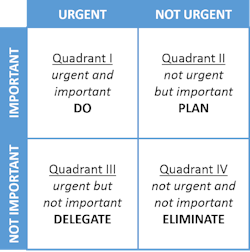
Many of us are enjoying an extended time of working from home – this odd juxtaposition of being in a familiar place, yet also trying to function in an unfamiliar work environment. Add to that the lack of variety or change in scenery and a certain monotony can creep in.
The Oxford Dictionary defines monotony as “tedious repetition and routine.” Does this sound familiar? How do we deal with and overcome it? And how do we lead our teams struggling through the same situation?
The short answer is to simply embrace the monotony. Tommy Kiedis, in his “Leader’s Life & Work” blog, suggests we should consider monotony as “the quiet brother of diligence” or “the sister of self-control” or even “the prelude to achievement.” A related note from the Book of Proverbs (10:4): “A slack hand causes poverty, but the hand of the diligent makes rich.”
The late Kobe Bryant was relentless in his routines. Before the 2012 Olympics, he would start his conditioning at 4:30 a.m., run and sprint until 6, lift weights until 7 and finally make 800 jump shots between 7 and 11. Then, he would go join Team USA for practice!
Tedium and routine are great avenues to personal and professional development. Imagine all that you can read or write during what would normally be your commute time. What if you used that time for exercise? All of these – and others – are great ways to stimulate the mind and body.
Deploy a Matrix
Specific to our work routines, monotony does not have to be synonymous with mundane. This is not about simply updating the file cabinet or sharpening pencils. There are many important things to be done each day; however, they often get prioritized down the to-do list in favor of more urgent tasks.Using the Eisenhower/Urgent-Important Matrix, many of these tedious (yet important) tasks fall into quadrant two, meaning not urgent, but important.
These are tasks that can easily be put off until tomorrow, next week, or even next month – and it is doubtful that anyone will notice. From a sales perspective, these are things like prospecting for new clients, checking-in with existing customers, following up on old quotes, connecting with vendor partners for updates, writing a blog post, recording a podcast, etc. These are activities that are not intended to produce immediate results; rather, they pay long-term dividends by focusing on strategic plans, building and strengthening relationships, and developing personally and professionally.
All of these principles and activities apply to our individual team members. So, how do we as leaders get the message out and get our teams on board? Assuming that they all know what to do and have done it before, the issue is really about motivation. Using the Situational Leadership model from Paul Hersey and Ken Blanchard, this becomes mainly a “participating/supporting” approach where you aren’t “telling” or “selling.” Rather, you are taking the journey together and helping them discover their inner motivation and the answer to the important question: “Why am I doing this?” As they become more motivated, you can then transition to more of a “delegating” role.
Here is a final thought on mastering the monotony: Ask yourself as an individual leader: “What are the routines that I need to repeat over and over to deliver my leadership best? What is absolutely essential to my leadership? Is it reading? Writing? Strategic thinking? Physical well-being? Mental well-being? Are these routines in order? If not, what needs to change?”
Tim Brooks is VP of Sales & Vendor Management for PSA Security Network. Request more info about PSA at www.securityinfowatch.com/10214742.

Tim Brooks
Tim Brooks is VP of Sales & Vendor Management for PSA Security Network. Request more info about PSA at www.securityinfowatch.com/10214742.



